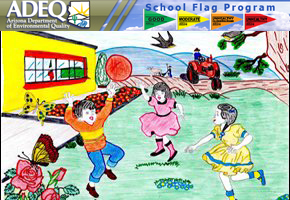
Since 2007, the Arizona Department of Environmental Quality (ADEQ) has been helping schools and other organizations to raise brightly colored, pennant-type flags to assist teachers, coaches, students, and members of the community become aware of daily air quality conditions. ADEQ’s Air Quality Flag Program is in place at schools, businesses, and health care facilities.
The program creates awareness of air quality conditions and encourages behaviors which limit additional emissions of air pollutants and protects children and other sensitive populations from the adverse effects of poor air quality.
ADEQ provides free program toolkits to all participating organizations. This toolkit contains:
- Sets of green, yellow, orange, and red flags that are color coded to represent the Air Quality Index (AQI)
- Fact sheets about the program and ozone and particulate pollution
- An outdoor activity guide
- Materials on the science of air quality
- Air pollution reduction techniques
The heart of the program is the daily air pollution forecast. By 1p.m. Sunday through Friday, ADEQ’s meteorologists prepare individualized air pollution forecasts for the pollutants of concern in nonattainment areas in Maricopa, Santa Cruz and Yuma counties. Forecasted air pollution concentrations are expressed consistently with the color-coded AQI, so that recipients know whether air quality will be good, moderate, or unhealthful for sensitive people.
If concentrations are predicted to be close to or exceed health-based standards, ADEQ issues High Pollution Advisories or Health Watches that are announced through email subscriptions, press releases and social media (Facebook and Twitter).
With this information, flag program participants know which flag color to raise to indicate the expected air pollution level. By comparing the colored flags to the AQI using the outdoor activity guide and educating the community, teachers, school nurses, coaches and parents will know what actions to take to protect their students' health and learn to take measures to control air pollution.
Strong partnerships have been crucial to the success of the program.
- ADEQ's Office of Children’s Environmental Health coordinates the school and community flag program and provides the ADEQ daily forecast, program training, flags and outreach materials at no cost.
- Through its Clean Air Make More campaign, the Maricopa County Air Quality Department promotes business participation in the fee-based program by providing flags, ADEQ daily forecasts, and supporting materials.
- The Pinal County Air Quality Department prepares and distributes its own forecast and has implemented the program at 50 schools and education-related facilities.
- In Santa Cruz County, the Mariposa Community Health Center coordinates local outreach with flags, forecasts and training from ADEQ.
- The Yuma County Health and Wellness Coalition implements the program with forecasts, toolkits, flags and guidance from ADEQ. Flag participants include three health community centers, Gadsden School District schools, Chicanos Por La Causa Head Start Centers, Desert View Academy and Carver Elementary.
Children are more susceptible to air quality because their lungs are still developing and they breathe more air per pound of body weight than adults. Chronic exposure to pollutants, even at moderate levels, may permanently decrease lung function. Reducing exposure to outdoor air pollutants is a simple way to protect children. In Arizona, approximately one in eight children suffers from asthma and an additional one in five suffer from allergies. For children suffering from asthma and allergies, approximately 40 percent are impacted by outdoor air quality.
Back
|